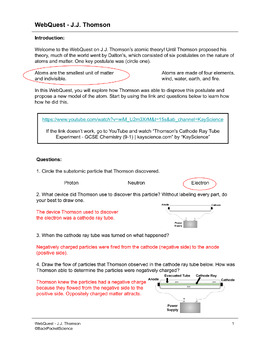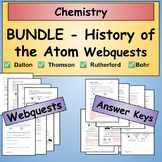WebQuest - J.J. Thomson - History of the Atom
- PDF
- Webquests
Also included in
- Unlock the fascinating history of the atom with our comprehensive bundle of four webquests! Dive into the remarkable contributions of the most influential scientists - John Dalton, J.J. Thomson, Ernest Rutherford, and Niels Bohr - and take your students on an immersive journey through the evolutionPrice $7.80Original Price $12.00Save $4.20
Description
Introducing a WebQuest on J.J. Thomson's Atomic Theory. This thoughtfully designed resource provides an in-depth exploration of Thomson's groundbreaking cathode ray tube experiment, and how it led to the discover of the electron and our modern understanding of the atom.
The WebQuest begins with a reference to Dalton's atomic theory and its core postulate that Thomson proved wrong. Then it moves to a video that introduces students to Thomson's cathode ray experiment and how he discovered the electron. While watching, students will answer questions and draw pictures.
At the end of the video students will complete a fill in the blank section that summarizes Thomson's work. Then they will draw the plum pudding model next to Dalton's model to see how they are different.
Included In This Product
- 2 pages of work
- 2 pages of answer keys
- 2 Links
- Diagrams
- Picture drawing
- A summary
- A comparison to Dalton's atomic model
Similar Products
WebQuest - John Dalton - History of the Atom
History of the Atom Mixed Review Worksheet
History of the Atom Matching Worksheet





